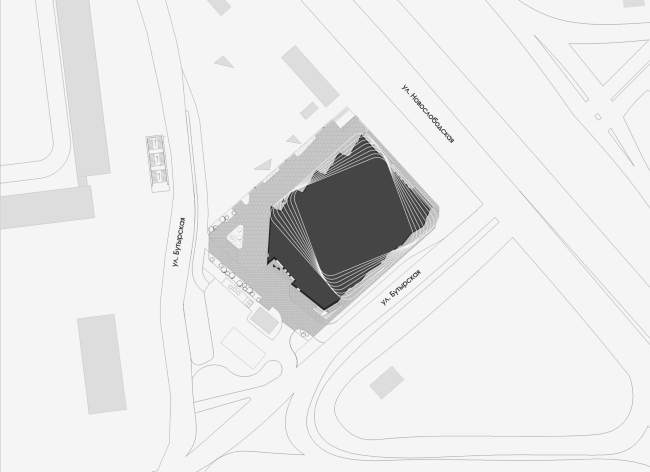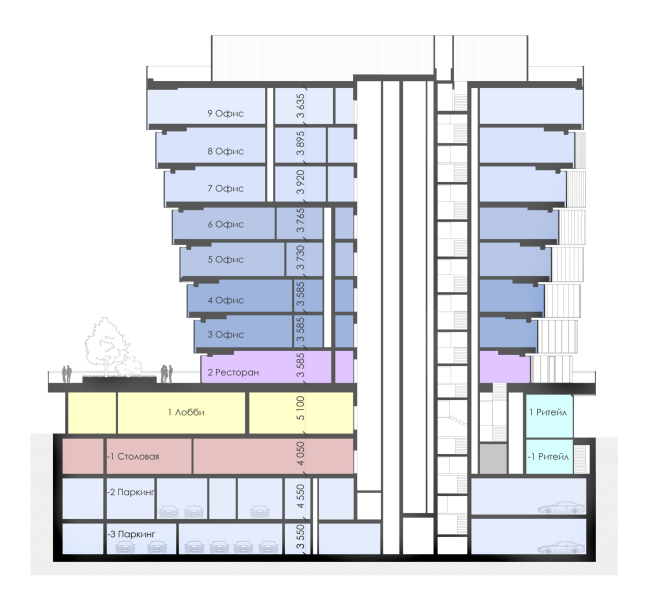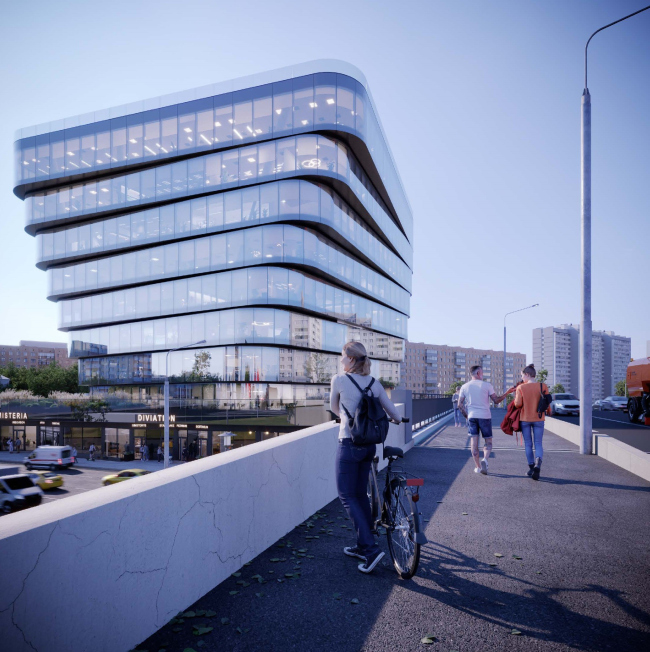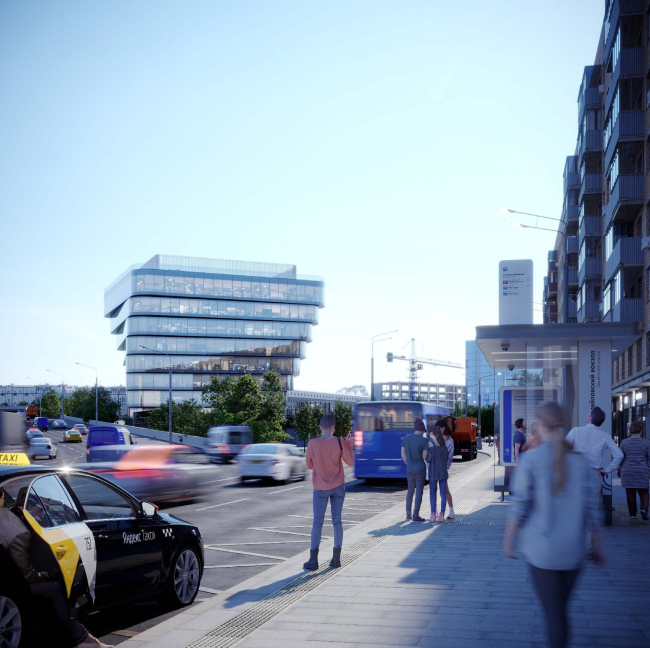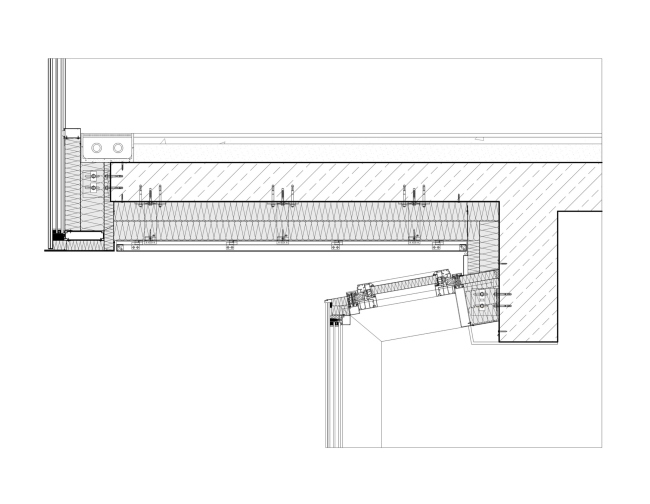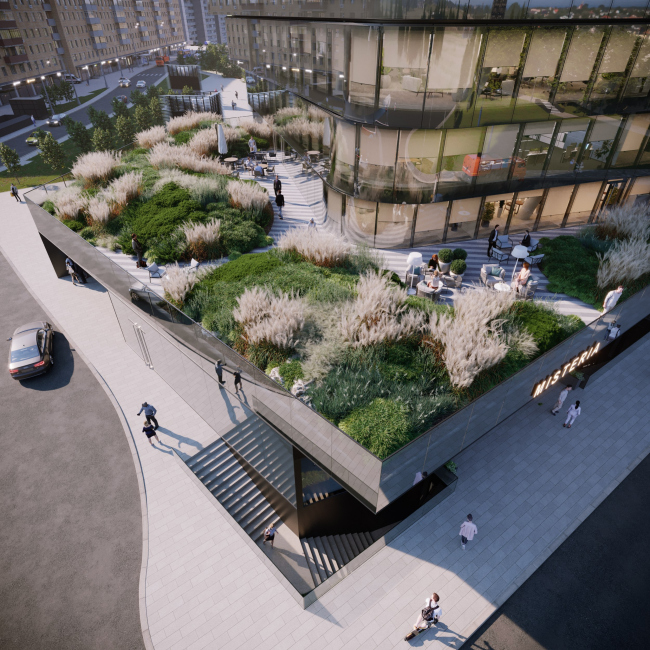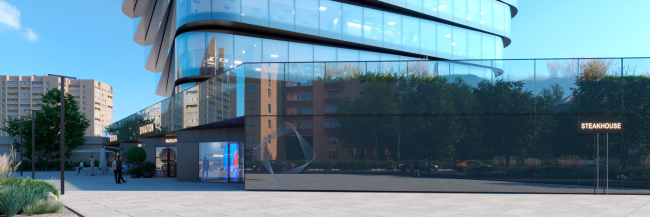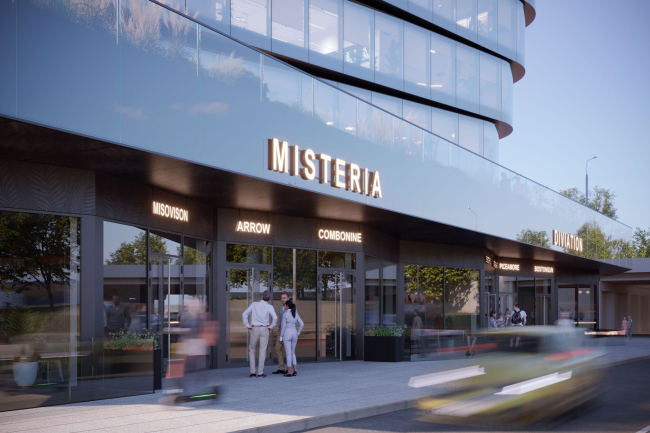|
Published on Archi.ru (https://archi.ru) |
|
| 28.11.2022 | |
|
The Savelovsky Axis |
|
|
Julia Tarabarina |
|
| Architect: | |
| Andrey Romanov | |
| Ekaterina Kuznetsova | |
| Studio: | |
| ADM | |
|
The business center, situated right in the middle of a large city junction next to the Savelovsky Railway Station takes on the role of a spatial axis, upon which the entire place hinges: it spins like a spiral, alternating perfect glass of the tiers and deep recessions of inter-tier floors that conceal little windows invented by the architects. It is sculptural, and it claims the role of a new city landmark, in spite of its relatively small height of nine floors. The business center Twist, which the company Sminex is building next to the Savelovsky Railway Station, will be situated on a triangular site situated in the middle of a large junction between the Third Transport Ring and the Dmitrov Highway. In the north part of the triangle, one of the metro station terminals is situated, and there is a gas station in its southwest corner. Otherwise, the site is completely vacant; even though it is “washed” by streams of car traffic on all sides, the streams that run along its hypotenuse and minor leg are not exactly intensive. The exit from the metro station is convenient for the office building, and generally the convergence of transportation lines is rather an asset. And, generally speaking, the territory next to the Savelovsky Railway Station somehow looks even too spacious, as if asking to be visually filled in. Thus, the appearance of a new business center here makes enough sense. Location plan. The business center on Butyrskaya StreetCopyright: © ADMThe spectacular solution – or should we even say “a plastique gesture” – proposed by Andrey Romanov and Ekaterina Kuznetsova, ADM architects, became the consequence of a few circumstances coming together. First, the top floors in office buildings have a higher value, and the client requested to make their area larger. This is why the building expands upwards “like a flower”, the ninth floor being almost twice as big as the second one. Cross-section view, simplified. The business center on Butyrskaya StreetCopyright: © ADMSecond, as was already said, the terrain here is pretty loose. There is nothing that could be taken for a starting point here: no lines, no volumes, and no directions that you can “lean on” or hold on to as a significant part of the town planning context. A junction is just a junction, and all the buildings and streets in its relative vicinity, be that new houses, “Stalin” houses or even the XIX-century railway station, are pretty remote and not really influential. The building of the future business center surrounded by motorways is enough of a landmark and an axis in itself – the architects decided. Accordingly, they span the entire volume counterclockwise – so that each subsequent floor not just increases its area but also makes a small turn (about 3 degrees) in respect to its predecessor; in total, all the 8 floors, from second to ninth, get a combined 27-degree turn. A screw. A spiral. A structure. And it looks particularly beautiful thanks to its tinted glass facades with rounded corners. The business center on Butyrskaya StreetCopyright: © ADMGenerally speaking, a house twisted like a spiral is a common technique in modern architecture, but it is more often seen in skyscrapers, while here we have 9 floors above ground (and 3 underground) – not much. On the other hand, the volume unambiguously takes on the role of a center, to which all nearest the corners, planes, and directions will ultimately flow. You often have to say, with a certain amount of metaphor, that the building “spins” the space around itself (“like a spinning wheel” ©) – well, in this specific case this figure of speech is tangibly close to literal. But it will surely be a head turner. Some kind of screw – perhaps it bores into the ground or perhaps in the sky. The business center on Butyrskaya StreetCopyright: © ADMAt the same time, the building is not excessively sculptural: it makes the most of what it has, and delivers maximum imagery without becoming either circular or star-shaped or looking like the Guggenheim Museum in Bilbao. Because this is a business center, and, in addition to the glass facades that ensure enough natural light and a fair share of “technology” glitter, it must display some sort of business-like seriousness. The history of this capacious form has, of course, its nuances and subtleties. For example, the brief provided for the expansion of not just upper, but also lower floors, and, if the architects had strictly stuck to the brief, the building would have had a “waist”: wide at top and bottom, and narrow in the middle. The architects, however, were able to persuade the client of the advantages of gradual development of the form – which is a rather rare case: both 3D renders and the architects must have been very convincing. Thus, the entire accessible construction blueprint (and the site has a lot of purely technical restrictions) is occupied by the first floor with cafés and stores, the second floor is also small, and then the tiers expand gradually, without any “waists”. The business center on Butyrskaya StreetCopyright: © ADMOther subtleties have to do with the rotation of the floors and ventilation. It is not advisable for the upper and lower walls to intersect at such an angle that the offset of the cantilever would bleed into a ledge: this is cost-ineffective because it requires double heat insulation and lowering the ceilings in at the intersection – explain the architects who already used this technique as part of the “wave” facade of the Alcon II business center. This way, in the Savelovsky building, all the lines are consistent, and no “intersections” appear: this is a reasonable economy not only of money but of form as well. On the other hand, the brief did contain a requirement to the effect that, in spite of the presence of central heating and air conditioning system, the architects should provide little windows (or “fortochkas”, as they are called in Russian) on the facades: not so much for adjusting the results of the work of the automatic systems as for the coworkers’ psychological comfort. However, regular fortochkas would have ruined the whole expressiveness of the streamlined glass facade. ADM architects proposed the following: each inter-floor band has a depression in it, a ledge about half a meter deep. The slitted openings are located precisely inside of it, and it will be possible to open and close them with a remote control. Also, in the depressions between the floors, the architects placed the backlighting: it is pointed from the bottom upwards, and this is why it will yield the kind of light that is not too bright, more a reflected kind, accentuating the border in the evening. By day, the ledges will cast deep shadows, marking the floors. Intermediate floor node. The business center on Butyrskaya StreetCopyright: © ADM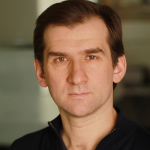 Andrey Romanov, ADM It was important for us to keep the integrity of the form; and at the same time, we understand the needs of people, the future office workers who may want to open the windows for some fresh air. So we have made every effort to correctly design the inter-floor nodes. When the small window (or “fortochka”) is open, the cool air will have to move along the glass from top to bottom, gradually mixing with the warm air inside the room – so we achieve delicate ventilation, at te same time avoiding drafts. Meanwhile, the quality of the plastique idea and its future implementation was paramount, we proposed this solution primarily in order to preserve and emphasize the plastique of the facades. Indeed, the visualizations show that the cantilevers between the floors play an important part in the perception: you could say that if the necessity for them did not exist, it would be necessary to invent it. The clear definition of the tiers makes a great contrast with the unrealistically glossy glass and accentuates the inner dynamics. It is common knowledge that if you squint at some houses from a driving car, they start to look as if they were moving, and in the finest examples of modern architecture this motion-in-perception contains a narrative carefully crafted by the author. And it seems that this is precisely the case here. The ledges help to maximize the visual experience. 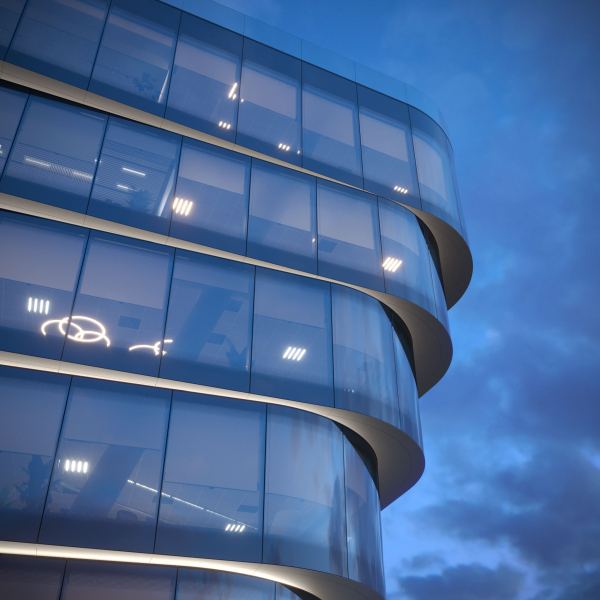 The business center on Butyrskaya StreetCopyright: © ADM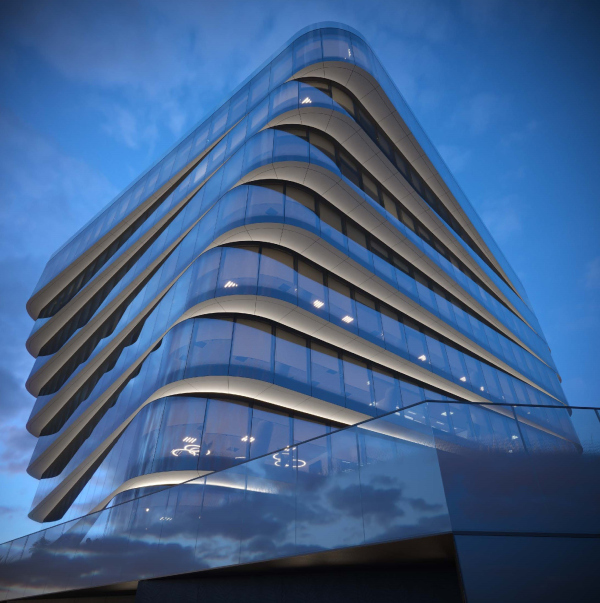 The business center on Butyrskaya StreetCopyright: © ADM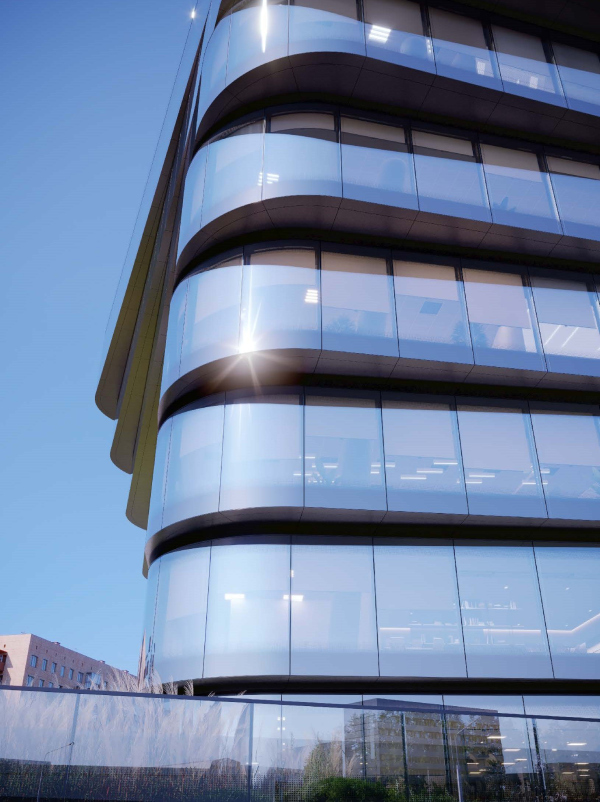 The business center on Butyrskaya StreetCopyright: © ADMThe first and minus-first floors, which contain retail, an office lobby, and a cafeteria, are interconnected, including by areaways and staircases, which make the pedestrian space around the building busier and more interesting. Not everyone likes a “flat city”, and the staircases and areaways create a spatial intrigue, just as the landscaped “terrace” roof above the first floor (as we remember, it is the second floor that has the smallest cross-section, this is where the growth of the spiral starts, and, hence, there is quite a lot of room on the roof of the stylobate tier). The business center on Butyrskaya StreetCopyright: © ADMThe business center on Butyrskaya StreetCopyright: © ADMThe longitudinal facades and the windows of shops and cafes on the first floor are designed as a “bellows” zigzag; on the south side the teeth are even and have a smaller offset, and on the north side they have a real “sawtooth” shape. “As a rule, it is expected that the main pedestrian flow will move towards the entrance in a straight line, and then the composition is predictable; in our case, however, people walk from the subway sideways, tangentially, and a straight facade would be perceived as being too simple and neutral. We turned the shop windows towards the visitors, accentuated the retail, and made the plastique of the first floor a little more complex and lively at the same time” – Andrey Romanov shares. The entrances are placed in triangular recesses; there are natural awnings above them. The business center on Butyrskaya StreetCopyright: © ADMThe business center on Butyrskaya StreetCopyright: © ADMConstruction is now intensively developing around the Savelovsky railway station and the Savelovsky market – from all sides: both inside the Third Transport Ring on the territory of the Pravda combine, and to the north, behind the market. The new business center is not the largest one among these buildings – it even, one might say so, acts “in small or medium weight”, by the standards of today’s Moscow mega projects. However, it does not seem that it will be invisible. On the contrary: a place surrounded by an expanse of the megalopolis, open to views from different angles, and a form found by the authors of the project that responds to both the task and the environment – all of this yielded a new landmark, and a noticeable accent. Although it echoes rounded corners with some other structures in the district – for example, those of the public center, the former Prague cinema (AL_A + FORMS) – acts completely independently, and even a little arrogantly. It is not often that such independent accents appear in the city. |
|
